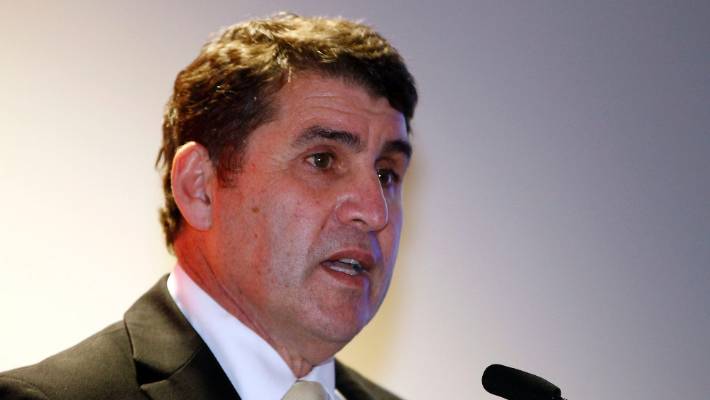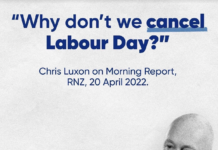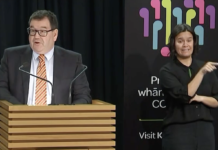What does a Treasury ‘Investor Confidence Review’ (ICR) and a poultry farm have in common? Nothing really apart from an exceptional climatic event – the central government bureaucratic coup against the leadership of Canterbury District Health Board (CDHB) in 2020.
The circumstances of this coup have been extensively covered by my three 2021 Democracy Project published articles. business consultants commissioned for hatchet job (9 February); very bureaucratic coup Part 1 (15 April) and very bureaucratic coup Part 2 (19 May).
Behind the coup: leadership culture clash
Since 2011 there had been a widening chasm in the relationship between the Ministry of Health and CDHB senior management team led by then Chief Executive David Meates. Until late 2019 Meates’ team was also supported by their governing board (thereafter it was increasingly undermined).
It began with the response to the earthquake devastation of 2010-11, including large-scale rebuilding and maintaining service provision such as in mental health. This was compounded by government failure to recognise that the normal funding formula for DHBs was poorly suited for natural disasters, a proposed Public Private Partnership, serious delays in rebuilding (managed by the Ministry but costly for CDHB including the anomalous capital charge), and attempts to restrict the capacity for service provision in the planned new facilities.

But more decisive was the widening gulf in leadership culture between the top-down Ministry and CDHB. Particularly since the mid-2000s, CDHB had been developing a strong engagement relationship with its health professional staff. The more senior management engaged with its health professionals the better informed it was in their advocacy to the Ministry.
The more Meates’ and his team were engaging with the expertise at the clinical frontline the more CDHB’s leadership became bottom-up. The more this happened the more it came into conflict with the Ministry’s top-down leadership. Inevitably tensions increased and relationships deteriorated over the above challenging issues (much of CDHB’s working relationships with the Ministry at lower levels, however, were constructive throughout).
CDHB was not an exemplar in workforce engagement but that is where it was tracking. Further, it was well ahead of the other DHBs. If other DHBs had experienced the earthquake devastation that Canterbury did, they would have been equally heroic.
However, such was the strength of the engagement between hospital and primary care in Canterbury, I doubt that (with the exception of West Coast) their local health systems would have been as resilient.
Execution of the coup
There were attempts to undermine and then remove David Meates in particular, but he and his team continued because they had the support of their Board, particularly its Chairs. Central government determination remained but shifted to an attack on the financial management of Meates’ team.
First, Lester Levy was appointed crown monitor by Health Minister David Clark in June 2019. Levy had previously been Chair at overlapping times of the three Auckland DHB leading to the departure of all three chief executives). Second, in December 2019, Clark appointed a ‘reliable’ Board Chair (John Hansen).

Finally the Ministry required CDHB to accept a financial management review by Ernst & Young (EY) consultants led by senior partner Stephen McKernan. Unsurprisingly the review proved to be a ‘hatchet job’. Meates’ team was attacked by misusing nursing staffing data to disingenuously claim that CDHB was over-staffed with nurses!
With the benefit of hindsight, also unsurprising is that McKernan now heads the Government’s Transition Unit to implement its health restructuring.

Egg yolk on faces
EY was at variance with independent reviews of CDHB’s financial management including annually by Audit NZ. However, this was not an environment conducive to impartiality or objectivity. The determined combined and coordinated pressures of the Ministry, Hansen, Levy and EY meant the inevitable departure of Meates and his team in 2020.
The reputations of those responsible for this poor financial management smear ended up in tatters following the clean bill of health given to CDHB in Audit NZ’s report for the year ended 30 June 2020 (published in 2021).

Despite best endeavours by Levy in particular to influence the review’s assessment, egg was left running down his face as discussed in my article published by the Democracy Project (24 September 2021) Egg yolk running down face.
Investor Confidence Review
Now an even more devastating review has been published (July 2021) whose authors are no less than the Treasury icr-results-analysis-jul21.pdf Further vindication of Canterbury DHB’s financial management under David Meates
So what is a Treasury Investor Confidence Review? It is a Cabinet-approval process for assessing state agencies investment performance. This is to assess the level of confidence ‘stakeholders’ should place in the ability of an agency to manage its assets and investments well. Cabinet had set the expectation that all ‘investment-intensive agencies’ should achieve at least a “B” rating over time.
The objectives of an ICR are two-fold:
- To reinforce the main objective of governments investment system which is to optimise value for New Zealanders.
- To provide an incentive mechanism that rewards good investment management and proactively addresses gaps.
An even more devastating review
There have been two rounds of ICR assessments over three-year periods of ‘investment-intensive agencies’, including eight larger district health boards (Northland, Waitemata, Auckland, Counties Manukau, Waikato, Capital & Coast, Canterbury, and Southern).
The first round was for 2015 to 2017 and the second was 2018 to 2020. There were 25 agencies covered in the two rounds but, for various reasons, only 23 in each round; Southern DHB wasn’t included in the first round and Northland DHB wasn’t in the second round (ie, seven DHBs in each round).

The Treasury considers the ICR assessments in Round 2 to be more robust and therefore more reliable than those in Round 1. Consequently, in order to maintain the same ICR score between rounds, agencies (including DHBs) would have had to make improvements in several elements compared with what existed at the time of the Round 1 assessment.
Both gradings from ‘A’ to ‘E’ and percentages are used by Treasury to rate and compare the 23 agencies in both 2015-17 and 2018-20.
If CDHB’s financial management was as bad as alleged by the Health Ministry led by Director-General of Health Ashley Bloomfield, by crown monitor Lester Levy, by EY led by senior partner Stephen McKernan, and by its politically appointed CDHB Chair John Hansen, one would have expected it to be ranked ‘D’ or ‘E’ and with a percentage well south of 50%.
Boy, did these bureaucratic coup leaders get it so badly wrong. CDHB under David Meates leadership was the best performing DHB in 2018-20. Along with Waitemata, Auckland and Counties Manukau, Canterbury was graded a ‘B’ but recorded the highest percentage (75%).
Further, consistent with Treasury’s expectations, Canterbury also improved from its rating in the first 2015-17 round; still a ‘B’ but increasing from 66% to 75%.
Talk about mud in the eyes of these coup leaders! But there is more. The monitored state agencies included the Ministry of Health. In the first round (15-17) its performance was mediocre with a ‘C’ grade but in the second (18-20) it collapsed to a very poor ‘D’.
The percentage drop highlights the hugeness of this performance disaster falling from 62% to 40%. This was contrary to Treasury’s expectations of improving performance. Further, only one of the other 20 agencies was rated as low as ‘D’ (Southern DHB).

What makes it even more embarrassing for the Director-General of Health is that under his watch the investor confidence of his Ministry declined well below what it was under his predecessor, the much criticised Chai Chuah.
Counties Manukau DHB also provides an interesting aside. When Lester Levy was appointed Chair of this DHB he attacked the financial leadership of its chief executive Geraint Martin (and his team).
This was the same tactic that he subsequently and predictably employed against David Meates in Canterbury. But, under Martin’s leadership, Counties Manukau was the top rated DHB in 2015-17 receiving an ‘A’. Subsequently its rating dropped to a still respectable ‘B’. Note the pattern!
Poultry farm yolk
This credibility debacle also raises serious issues of political leadership. While Annette King as a former health minister and Labour’s health spokesperson rated Canterbury’s leadership under Meates positively, these coup leaders managed to convince three successive Labour health ministers (Clark, Hipkins and Little) otherwise. The former have now severely tarnished the judgment and reputations of the latter.
Audit NZ’s assessment of CDHB’s financial under the leadership of David Meates left the bureaucratic coup leaders with egg yolk running down their faces. Now Treasury’s investor confidence leaves their faces drowning in an entire free-range poultry farm of egg yolk.
If these four coup orchestra conductors were judged in the same way as they judged David Meates and his senior management team, all four would be summarily shown the door. Words like geese and gander come to mind. So do several expletive deletives!
Ian Powell was Executive Director of the Association of Salaried Medical Specialists, the professional union representing senior doctors and dentists in New Zealand, for over 30 years, until December 2019. He is now a health systems, labour market, and political commentator living in the small river estuary community of Otaihanga (the place by the tide). First published at Otaihanga Second Opinion






And some commentators on this blog want government to have total control of water and start a grocery shop.
You nailed it Trev!
The place that needs an audit is clearly the MoH itself and the MoE and….
As far as I know, Lester Levy, John Hansen & Stephen McKernan are not Labour party MP’s while it is also highly unlikely that they are Labour party members. My understanding from this example is that certain sections of the public service are more interested in empire-building than in actually providing a public service.
I am not willing to speculate on what philosophy motivates the 3 individuals mentioned although I am sure that other readers will be keen to contribute.
That is why Like Ian Powell I have no confidence in this new bullshit Health NZ .
Just watch as the MOH Bureaucrats try to cut health spending.
I can see it coming a mile off.
The savings from having less so called Dhb’s will be used as a justification to cut it.
The same amount as being spent now will not carry on that is a foregone conclusion and our health system will continue to deteriorate .
The MOH bosses want a business oriented semi privatised health system .
KEEP UP THE PRESSURE IAN.
That is why Like Ian Powell I have no confidence in this new bullshit Health NZ .
Just watch as the MOH Bureaucrats try to cut health spending.
I can see it coming a mile off.
The savings from having less so called Dhb’s will be used as a justification to cut it.
The same amount as being spent now will not carry on that is a foregone conclusion and our health system will continue to deteriorate .
The MOH bosses want a business oriented semi privatised health system .
KEEP UP THE PRESSURE IAN.
Bloody marvellous Trevor.
This that the water that nobody owns Trev ?
yea and some commentators here are just filled with hatred of anything that’s not ‘them’ trev.
see what’s just happened in the UK, most of the gas infrastructure sold to OZ and Canuk wealth management companies…..are we 100percent sure our water won’t go the same way.
I have complete faith in my officials in this space, going forward. It’s everyone else that’s the problem
Strange as it may seem (since I’m generally quite cynical about the state of our neoliberally trained PS CEOs), I had suspicions that Saint Ashley was an exception and just not that capable of standing up to one or two of his uber competitive careerist underlings. Now his deputy dawg has resigned.
Probably a bit like OT, and MBIE. and MSD, and bits of DIA. Institutions that need to be demolished and rebuilt from the ground up using people that haven’t either just been parachuted in from somewhere in the Empire, or recruited from private sector business-oriented senior management.
indeed tim
Reading about the rich soup being imbibed by E&Y and the health dept and gummint I am reminded of the BBC business series around 2000 called Blood on the Carpet. We would have some good stories here.
https://www.theguardian.com/media/2001/jan/22/broadcasting
Jan.2001
In the past, Blood on the Carpet has tackled Gerry Robinson’s hostile Granada takeover of Mr Forte’s hotel business and the short and unhappy alliance between royal-wedding-dress designer Elizabeth Emanuel and Joe Bloggs founder Shami Ahmed.
And all this mess and the failed bureaucracy within our current health system highlight the importance of Maori having our own equally funded health authority. We already know the health system has and continues to fail us as a people. The evidence is there and it has been for some time yet we continue to ignore it and carry on and do the same old stuff with the same negative outcomes its time to give us a turn as nothing can be worse than how it is now.
HUMMM HUMM (COUGH) surely you mean 15percent of the funding given to the general health budget….and will Maori and ‘the rest’ be treated at all hospitals or will they be ‘segregated’, because frankly if we refuse to adequately fund one health system, two have no chance…or is it just ‘job creation’ for a slew of Maori middle managers?
“…or is it just ‘job creation’ for a slew of Maori middle managers?”
Of course it is! Sadly as I can see the benefit of the Maori Health Authority.
Hopefully it will collect enough data to comprehensively identify the predominate health issues experienced by Maori(once and for all) so the treatment of ( diabetes, kidney disease for example)these health problems will get the targeted funding and equipment necessary. I know Kaitaia hospital could use more dialysis machines . If Maori did not have to travel to base hospitals for the necessary health treatments much funding could efficiently be directed at need.
frankly shona we know the health issues around maori and pasifika measuring them again won’t help them, action might…the 1st action being adequately fund our current health system.